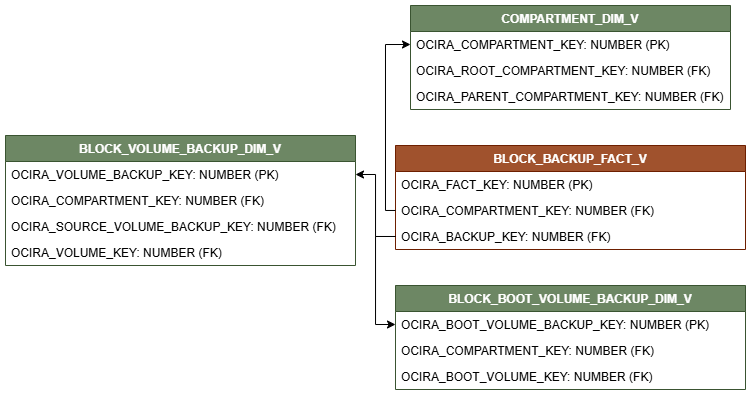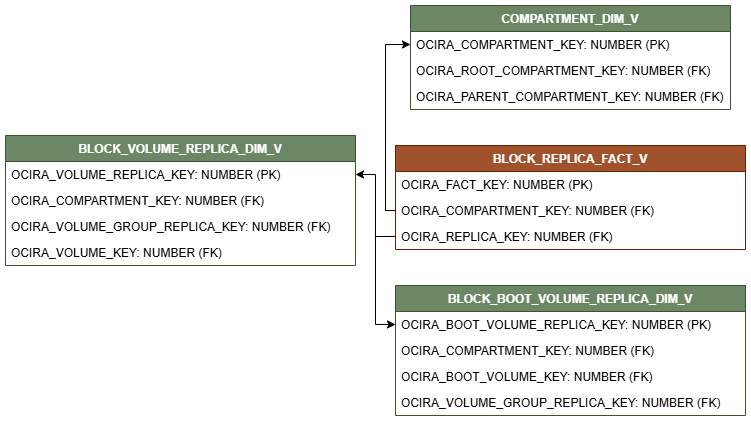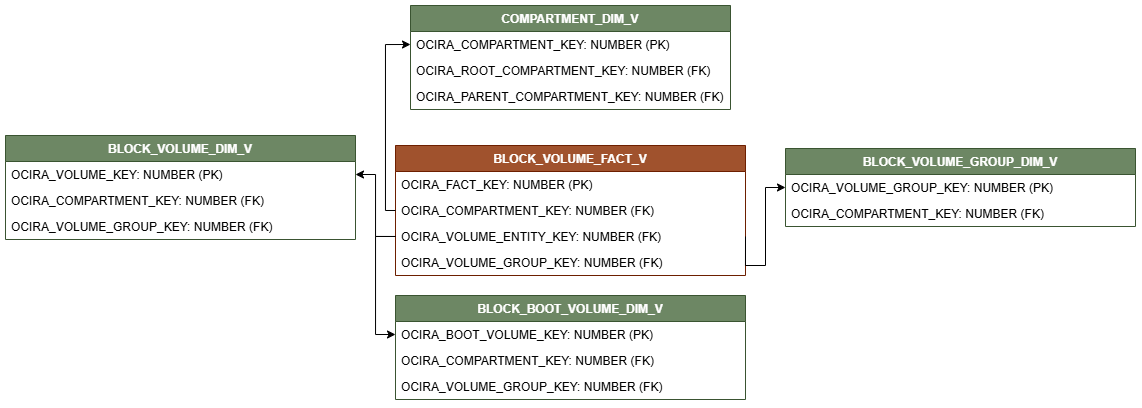Reference for Block Volume
This guide lists the predefined objects in Resource Analytics for the Oracle Block Volume service. You can find information about views, entity relationships, subject areas and sample queries.
Views
| View Name | View Description |
|---|---|
| BLOCK_BACKUP_POLICY_V | This view stores information on policies for automatically creating volume backups according to a recurring schedule. Has a set of one or more schedules that control when and how backups are created. |
| BLOCK_BOOT_VOLUME_BACKUP_DIM_V | This view stores information on point-in-time copies of a boot volume that can then be used to create a new boot volume or recover a boot volume. |
| BLOCK_BOOT_VOLUME_DIM_V | This view stores information about the detachable boot volume device that contains the image used to boot a Compute instance. |
| BLOCK_BOOT_VOLUME_REPLICA_DIM_V | This view stores information about the asynchronous replica of a boot volume that can then be used to create a new boot volume or recover a boot volume. |
| BLOCK_VOLUME_BACKUP_DIM_V | This view stores information about point-in-time copies of a volume that can then be used to create a new block volume or recover a block volume. |
| BLOCK_VOLUME_DIM_V | This view stores information about detachable block volume devices that let you dynamically expand the storage capacity of an instance. |
| BLOCK_VOLUME_GROUP_BACKUP_DIM_V | This view stores information on point-in-time copies of a volume group that can then be used to create a new volume group or restore a volume group. |
| BLOCK_VOLUME_GROUP_DIM_V | This view stores information on volume groups which are a collection of volumes. |
| BLOCK_VOLUME_GROUP_REPLICA_DIM_V | This view stores information about asynchronous replicas of a volume group that can then be used to create a new volume group or recover a volume group. |
| BLOCK_VOLUME_REPLICA_DIM_V | This view stores information about asynchronous replicas of block volumes that can then be used to create a new block volume or recover a block volume. |
| BLOCK_BACKUP_FACT_V | Fact for block backups. It Includes boot volume backups and volume backups. The measures include backup size. |
| BLOCK_REPLICA_FACT_V | Fact for block replicas. It includes volume replicas and boot volume replicas. The measures include replica size. |
| BLOCK_VOLUME_FACT_V | Fact for block volumes. It includes volumes and boot volumes. The measures include volume size, replica count, and backup size/count. |
| BLOCK_VOLUME_BACKUP_COMBINED_DIM_V | A denormalized view combining the data for block volume backups and boot volume backups. It combines data from BLOCK_VOLUME_DIM_V and BLOCK_BOOT_VOLUME_BACKUP_DIM_V. |
| BLOCK_VOLUME_COMBINED_DIM_V | A denormalized view combining the data for block volumes and boot volumes. It combines data from BLOCK_VOLUME_DIM_V and BLOCK_BOOT_VOLUME_DIM_V. |
| BLOCK_VOLUME_REPLICA_COMBINED_DIM_V | A denormalized view combining the data for block volume replicas and boot volume replicas. It combines data from BLOCK_VOLUME_REPLICA_DIM_V and BLOCK_BOOT_VOLUME_REPLICA_DIM_V. |
The suffixes in the view names specify the view type:
- FACT_V: Fact
- DIM_V: Dimension
- COMBINED_DIM_V: Denormalized view
Relationship Diagram
This section provides diagrams that define the logical relationship of a fact table with different dimension tables.
The contents of each view and their relationships are listed in the following file: block volume views.
These diagrams show the relationship of the block volume fact view with different dimension views.



Relationships exist among dimensions. Dimensions can be joined directly to each other. These diagrams show the relationship between dimension views.

Sample Queries
Sample queries for block volume.
SELECT TAG_TYPE, TAG_KEY_NAME, TAG_VALUE
FROM OCIRA.TAGS_DIM_V
WHERE RESOURCE_TYPE = 'volume';SELECT BV.ID AS VOLUME_ID, BV.DISPLAY_NAME, BV.SIZE_IN_GBS, BV.COMPARTMENT_ID
FROM OCIRA.BLOCK_VOLUME_DIM_V BV
LEFT JOIN OCIRA.COMPUTE_VOLUME_ATTACHMENT_DIM_V VA
ON BV.ID = VA.VOLUME_ID
WHERE VA.VOLUME_ID IS NULL;SELECT V.ID AS VOLUME_ID, V.DISPLAY_NAME, V.SIZE_IN_GBS, V.COMPARTMENT_ID, VA.ATTACHMENT_TYPE, VA.INSTANCE_ID
FROM OCIRA.BLOCK_VOLUME_DIM_V V
LEFT JOIN OCIRA.COMPUTE_VOLUME_ATTACHMENT_DIM_V VA
ON V.ID = VA.VOLUME_ID
WHERE VA.LIFECYCLE_STATE = 'Attached';SELECT ENTITY_TYPE, VOLUME_ENTITY_ID, SIZE_IN_GBS
FROM OCIRA.BLOCK_VOLUME_FACT_V
WHERE COMPARTMENT_ID = '<insert compartment ID>';SELECT VOLUME_ID, ID, DISPLAY_NAME, LIFECYCLE_STATE, SIZE_IN_GBS, TIME_CREATED, EXPIRATION_TIME
FROM OCIRA.BLOCK_VOLUME_BACKUP_COMBINED_DIM_V;
Data Lineage
The Customer Experience Semantic Model Lineage spreadsheet and Metric Calculation Logic spreadsheet for block volume provides an end-to-end data lineage summary report for physical and logical relationships in your data.
For more information, see Data Lineage.
Subject Areas
This section provides information on the subject areas with data you maintain in network Block Volume. These subject areas, with their corresponding data, are available for you to use when creating and editing analyses and reports. The information for each subject area includes:
-
Description of the subject area.
-
Business questions that can be answered by data in the subject area, with a link to more detailed information about each business question.
-
Job-specific groups and duty roles that can be used to secure access to the subject area, with a link to more detailed information about each job role and duty role.
-
Primary navigation to the work area that's represented by the subject area.
-
Time reporting considerations in using the subject area, such as whether the subject area reports historical data or only the current data. Historical reporting refers to reporting on historical transactional data in a subject area. With a few exceptions, all dimensional data are current as of the primary transaction dates or system date.
-
The lowest grain of transactional data in a subject area. The lowest transactional data grain decides how data are joined in a report.
-
Special considerations, tips, and things to look out for in using the subject area to create analyses and reports.
Other References
This section provides other references related to block volume.
- Oracle Cloud Infrastructure Block Volume Documentation
- VolumeBackupPolicy Reference
- BootVolumeBackup Reference
- BootVolume Reference
- BootVolumeReplica Reference
- VolumeBackup Reference
- Volume Reference
- VolumeGroup Reference
- VolumeGroupBackup Reference
- VolumeGroupReplica Reference
- BlockVolumeReplica Reference